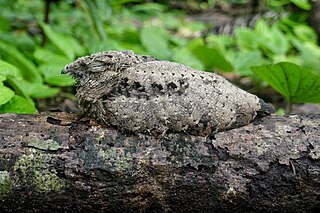
The African snipe also known as the Ethiopian snipe, is a small stocky wader. It breeds in eastern and southern Africa in wet mountain moorland and swamps at altitudes of 1,700–4,000 m (5,600–13,100 ft). When not breeding it disperses widely, including into coastal lowlands.

The black-winged petrel is a species of seabird in the family Procellariidae. It breeds on a number of oceanic islands in the tropical and subtropical East Pacific Ocean and spends the rest of the year at sea.

The black-winged oriole is a species of bird in the family Oriolidae. It is found in Africa from Sierra Leone and Liberia to southern South Sudan, western Uganda, central Democratic Republic of Congo and north-western Angola.

Saperdini is a tribe of longhorn beetles of the subfamily Lamiinae.

The Solomons nightjar is a species of nightjar in the family Caprimulgidae. It is found in the Solomon Islands archipelago. Its natural habitat is subtropical or tropical dry forests. It avoids human activity, and is nocturnal.
Serixia is a genus of longhorn beetles of the subfamily Lamiinae, containing the following species:
Serixia buruensis is a species of beetle in the family Cerambycidae. It was described by Stephan von Breuning in 1958.
Serixia cinereotomentosa is a species of beetle in the family Cerambycidae. It was described by Stephan von Breuning in 1958.
Serixia novaebritanniae is a species of beetle in the family Cerambycidae. It was described by Stephan von Breuning in 1958.
Serixia fumosa is a species of beetle in the family Cerambycidae. It was described by Francis Polkinghorne Pascoe in 1867. It is known from Sumatra and Borneo.
Serixia literata is a species of beetle in the family Cerambycidae. It was described by Francis Polkinghorne Pascoe in 1858. It is known from Malaysia, Borneo and Sulawesi.
Serixia longicornis is a species of beetle in the family Cerambycidae. It was described by Francis Polkinghorne Pascoe in 1858.
Serixia prolata is a species of beetle in the family Cerambycidae. It was described by Francis Polkinghorne Pascoe in 1858.
Serixia sedata is a species of beetle in the family Cerambycidae. It was described by Francis Polkinghorne Pascoe in 1862.
Serixia phaeoptera is a species of beetle in the family Cerambycidae. It was described by Per Olof Christopher Aurivillius in 1927.
Serixia nigroapicalis is a species of long horn beetle in the family Cerambycidae. It was described by Per Olof Christopher Aurivillius in 1927. This species is also part of the genus Serixia, order Coleoptera, class Insecta, phylum Arthropoda, and kingdom Animalia. These beetles can drill into wood and cause damage to live wood.
Serixia atritarsis is a species of beetle in the family Cerambycidae. It was described by Maurice Pic in 1929.
Serixia trigonocephala is a species of beetle in the family Cerambycidae. It was described by Heller in 1915.
Serixia inconspicua is a species of beetle in the family Cerambycidae. It was described by Gardiner in 1936.
Homalocnemis is a genus of flies which is placed in a family of its own, the Homalocnemidae. There are about seven species in the genus found in the Afrotropical, Neotropical, and Australasian regions, suggestive of a Gondwanan origin. The genus was formerly considered a primitive empidoid and placed variously in the Hybotidae or in the empidid subfamily Brachystomatinae. They are recognized by their wing venation which includes a long anal cell and a long basal segment of the antennal style.




